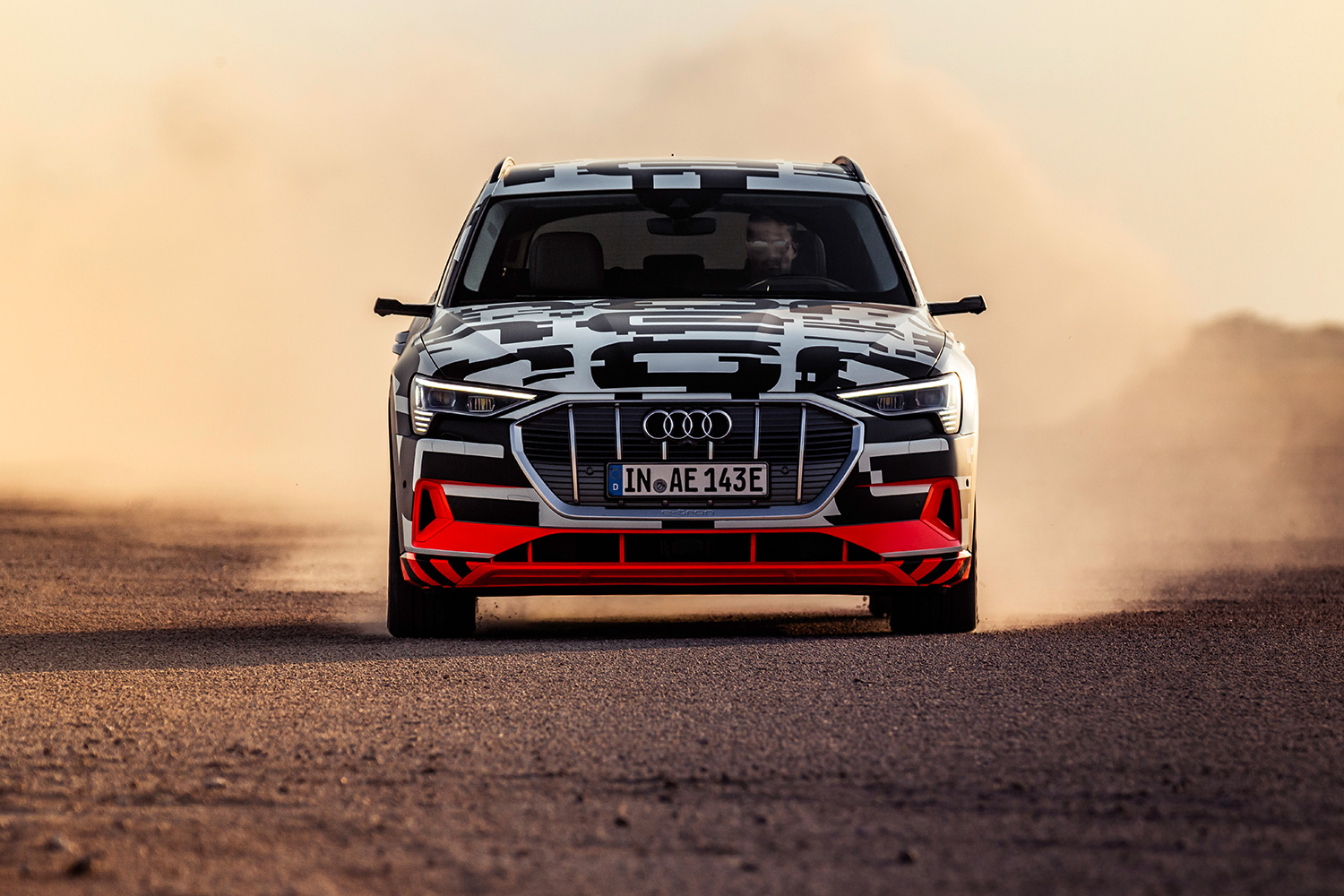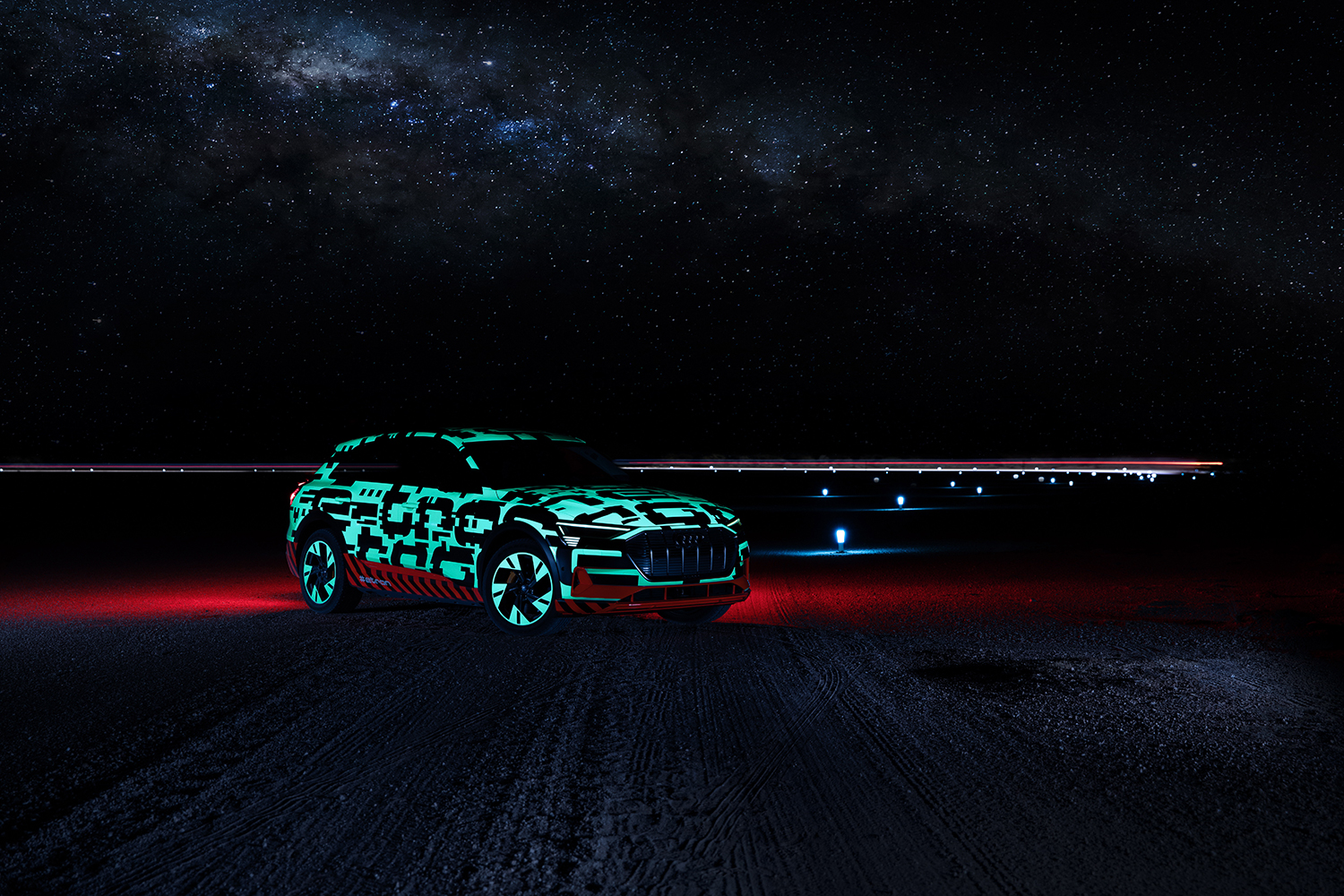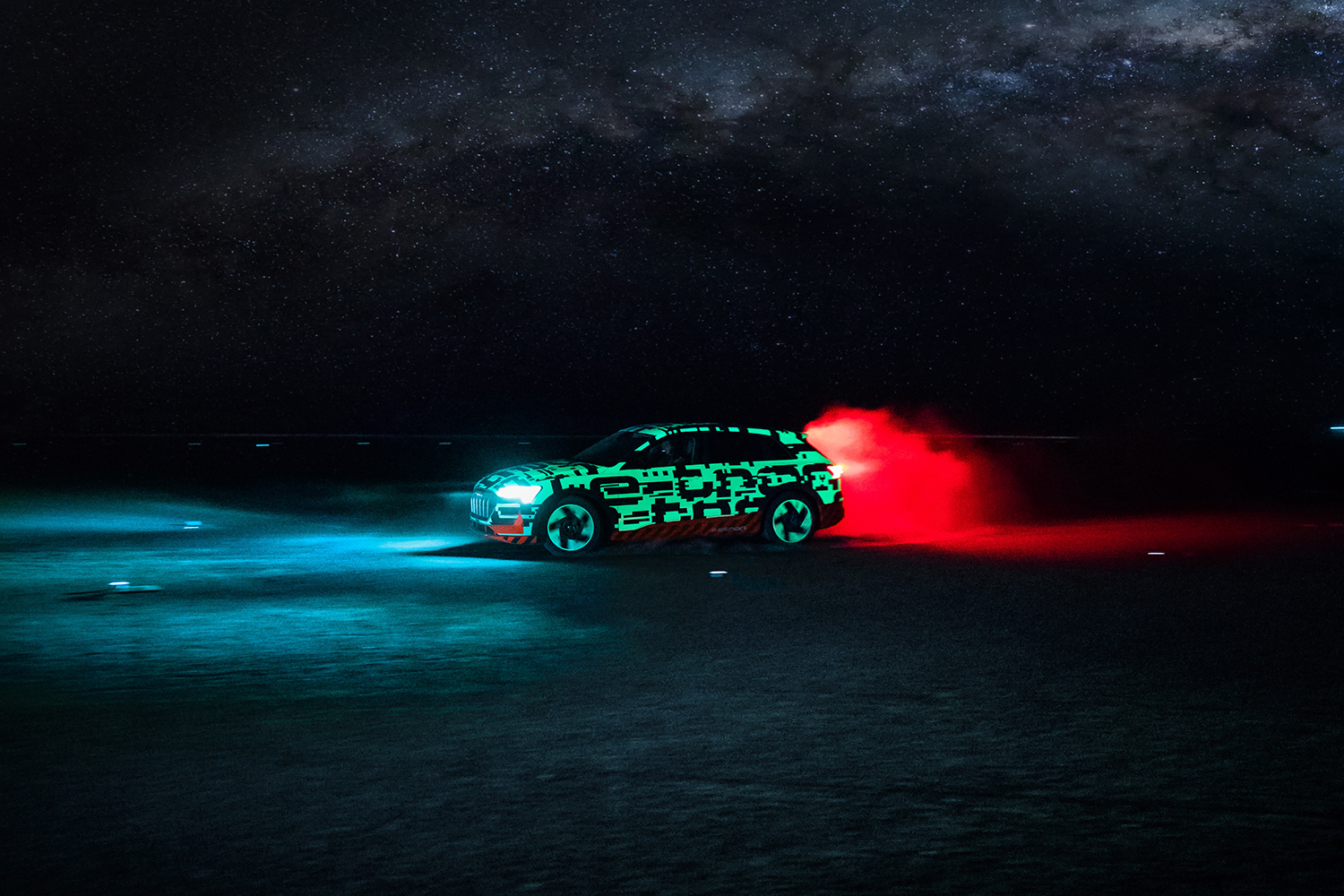Audi is on the home stretch.
The German firm is wrapping up the busiest year in its history by launching the E-Tron, one of the most significant cars ever to wear the four-ring emblem. It’s not just another board meeting-bred SUV made to capitalize on the body style’s skyrocketing popularity; it’s a brand-new electric car jettisoned into one of the hottest, most competitive segments of the market. While the first deliveries aren’t scheduled until 2019, we trekked out to Namibia to get a preview of what the E-Tron is like to drive.
The untold tales of a globe-trotter
The white, orange, and black livery is camouflage applied to the first pre-series prototypes Audi built in order to put the E-Tron through its paces all around the world without revealing the final design. We caught our first glimpse of these test mules in Geneva, Switzerland, in March of 2018. We’ve occasionally seen them giving it all on the German autobahn. We even got to ride in one down Pikes Peak in Colorado a few weeks before the E-Tron’s official debut in San Francisco. Road-tripping across Namibia is just another day in the life of a prototype. We wouldn’t be surprised to see them shivering through Christmas in a remote part of Scandinavia well north of the Arctic Circle. None will live to tell the tale; not only can they not talk, unfortunately, but they’ll all get crushed when testing ends.

From a visual standpoint, the differences between the prototype we drove and the model that will arrive in showrooms in 2019 are few and far between. We’ve seen the model in the metal already so we know exactly what to expect. It’s the same story inside, though Audi told us the regular-production models will be better assembled with higher-quality materials than the prototypes we drove. And, although functions like the navigation were disabled in our test cars, we recognized the company’s intuitive dual-screen MMI Touch Response infotainment system. It’s carried over from other models like the Q8, the A8, the A6, and the A7. The latest Q3 uses a single-screen version of it.
Road-tripping across Namibia is just another day in the life of a prototype.
Don’t pay much attention to the cameras mounted where you’d normally find the mirrors, or to the touch-sensitive screens in the door panels that they transmit their footage to. It’s a neat feature that will certainly spread across the industry in the coming decade but it’s illegal in the United States as of 2018. Audi will need to install conventional mirrors to sell the E-Tron here.
The E-Tron stretches 193 inches long, 76.3 inches wide, and 65.5 inches tall. Those figures make it about 10 inches longer than a Q5 – and five shorter than a Q7 – but roughly as wide and as tall. There is spacious seating for five passengers inside, though the floor isn’t as flat as the battery pack suggests. Audi had to punch a small tunnel down the center of the car to make space for the high-voltage wires. Trunk space checks in at 28.5 cubic feet, and there’s a small frunk under the hood that’s handy for hiding valuables out of sight or storing the charging cable.
The Quattro network
At its core, the E-Tron’s powertrain consists of two electric motors – one for each axle – and a 95-kWh lithium-ion battery pack mounted right in the middle of the car. Remove the body and you’ll find an architecture that looks a little bit like a skateboard with the wheels pushed further out. Picture a long-wheelbase skateboard and you’re in the right ballpark. The motors deliver approximately 400 horsepower and 490 pound-feet of torque when a temporary overboost function kicks in, while the battery pack holds enough electricity to make the 200-mile, 7,000-foot climb from San Francisco to Lake Tahoe. Audi will release full specifications (like output, range, and weight) about the American-spec model closer to its on-sale date.

Engineer Tobias Greiner compared the powertrain his team developed to a network. The different components share information and work together to decide how much torque each axle needs in real-time. For example, if the armada of sensors detects understeer during hard cornering it will brake the inside wheels to counter it. If the sensors detect that the rear axle loses traction they’ll send more torque to the front wheels to keep the car moving. Every process is electronic so the changes happen almost instantaneously; there’s no mechanical connection between the front and rear axles. Audi claims the torque transfer happens up to 50 times faster than before.
Turning the ESC system completely off opens the doors to drifting and all sorts of other high-speed shenanigans.
In real life, this high-tech evolution of Audi’s decades-old Quattro system helps the E-Tron tackle a variety of terrains. We tried it in the dunes of the Namibian desert and on a salt pan whose surface was about as slippery as snow. On the dunes, we applied the basic principles of off-roading (e.g., don’t stop on a steep hill) and never lost traction, even while plowing through sand that came up to the car’s hubs. The built-in Offroad mode – which pumps the air suspension to add two inches of ground clearance – and the hill descent control system brought us peace of mind while navigating an unfamiliar landscape.
It’s reassuring, though Audi has you covered if you want to lose traction. Turning the electronic stability control (ESC) system completely off – yes, you can do that – opens the doors to drifting and all sorts of other high-speed shenanigans that normally come with an asterisk corresponding to “professional driver on a closed course.” But go ahead and try it if you get the chance; we won’t tell anyone. While you’re sideways, the E-Tron remains completely silent save for the faint, distant whine of the motors. Straighten the steering wheel as you exit a bend and the E-Tron rides the two motors’ instant torque to build up speed in a brisk, controlled manner.
The E-Tron has another tech trick up its sleeve. When you press the brake pedal, you send a signal to a control unit that electronically distributes the brake force. That’s assuming the hydraulic system comes into play; sometimes the pads stay put and the brake energy recuperation system slows down the car when the driver lifts off the accelerator pedal to channel electricity back to the battery pack. Audi fitted the pedal with a simulator to preserve a natural brake feel regardless of how the car stops.
Regeneration accounts for up to 30 percent of the E-Tron’s range, according to the company. Out on the track, we used the steering wheel-mounted paddles to dial in the most aggressive regeneration setting and took our foot off the accelerator — instead of applying the brakes — to slow down before entering a mild bend. Slowing down for a sharp turn required using the conventional the brakes.
Solid foundation
Judging from the prototypes we drove in Namibia, the 2019 Audi E-Tron is poised to make a splash in the electric car world. We’ll reserve our final judgement until we spend time behind the wheel of a regular-production model, however. Only then will we be able to tell you how it compares to the Jaguar I-Pace, one of its closest rivals, and where it stands in the electric car pecking order.

We won’t have to wait long to find out. The Audi E-Tron will arrive in showrooms during the first half of 2019. Pricing starts at $75,795 before local and federal incentives enter the equation, though the first 999 examples will form a special series called First Edition priced at $87,695. Those are already sold out, but customers who want to be first in line when deliveries start can secure an early build slot by sending the company a refundable $1,000 deposit.
Editors' Recommendations
- Audi Q6 e-tron ushers in the automaker’s next EV phase
- Audi’s electric 2022 Q4 E-Tron packs big tech, lots of space in compact package
- The best electric SUVs
- Audi’s stylish E-Tron Sportback will teach its other EV new tricks
- One version of the electric Ford Mustang Mach-E is already sold out
















